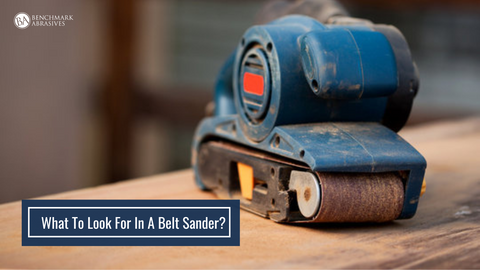
What To Look For In A Belt Sander?

The belt sander is the most efficient and aggressive tool available for stock removal, flattening large surfaces, and rapid shaping. Whether you are buying your first model or upgrading, selecting the right machine requires assessing its power (Amperage), speed (FPM), and mechanical design.
We examine key characteristics below, focusing on the features that dictate efficiency, durability, and user safety.
Portable vs. Stationary Models
"Belt Sander" generally refers to two distinct categories of equipment:
-
Portable Belt Sanders: These are hand-held machines (like a 3" x 21" model) used to aggressively sand and flatten large, fixed workpieces like doors, floors, or tabletops. This guide focuses primarily on these portable units.
-
Stationary Belt Sanders: These are bench-mounted or floor-standing machines (often with a 6" x 48" or larger belt) used for shaping, grinding, squaring the ends of small workpieces, or sharpening tools.
Performance and Cutting Efficiency
The aggressive nature of a belt sander means you must prioritize the motor's ability to maintain torque and speed under load.
1. Motor Power (Amperage)
Amperage (Amps) is the single most critical indicator of a portable belt sander's power and its ability to handle demanding tasks without slowing down or "bogging down."
-
A light-duty sander typically has 6 Amps or less.
-
A powerful, industrial-grade sander for heavy stock removal and long-duration tasks will range from 8 to 10 Amps. Higher amperage provides the necessary torque to aggressively remove material without overheating the motor.
2. Variable Speed (FPM)
The actual speed of the belt is measured in Feet Per Minute (FPM), and variable speed control is a crucial feature.
-
A high FPM (upwards of 1,000 FPM) is ideal for maximum stock removal.
-
Dialing down the speed is essential when working with delicate materials or materials that melt easily, such as plastics, composites, or hardwoods high in resin, which generate excessive heat at high speed. The speed control is typically adjusted via a dial next to the handle.
3. Belt Dimension and Size
The width and length of the sanding belt specify the size of a belt sander. A common and versatile size for home workshops is the 3" x 21" model, which balances a sizable sanding area with manageable weight. Larger machines (4" x 24") are reserved for very heavy-duty work and are often fatiguing to operate for long periods.
User Experience and Durability Features
These features affect the quality of the finish, the lifespan of your belts, and your comfort during prolonged use.
4. Platen and Material
The platen is the plate on the sander's base that makes contact with the workpiece. It must be perfectly flat to prevent the sander from producing a wavy or "dished" surface.
-
Metal Platens: Often thin and prone to warping or deforming under the downward pressure exerted by the operator.
-
Graphite Platen (Upgrade): Graphite is a type of smooth, durable carbon that is resistant to warping or buckling at high temperatures. Switching to a graphite platen is an excellent upgrade because it effectively dissipates heat, dramatically reducing friction and preventing pitch/resin from melting and clogging the belt. You'll achieve a flatter, more uniform sanding surface, and your belts will last longer.
5. Tracking System
Tracking refers to how well the belt remains centered on the platen. If the front and rear rollers are misaligned, the belt can rub against the housing or disengage entirely.
Look for a sander with a precise tracking adjustment knob (thumbscrew) that allows for gradual, fine-tuning of the front roller's alignment. Some models offer "auto-tracking," but manual fine-tuning is usually still necessary.
6. Dust Collection
A belt sander generates a massive volume of fine dust quickly. Strong dust collection is mandatory for safety and visibility.
Prioritize models with a large, efficient dust bag and, more importantly, a dust port or adapter that connects directly to a shop vacuum or dust collector. This connection is far more effective than the standard dust bag.
7. Ergonomics
Even moderate-sized belt sanders require a firm grip and can be fatiguing. Ergonomics directly impacts control and safety. Look for:
-
Well-placed handles that lessen strain during prolonged use.
-
Two-position handles that can be adjusted to complement different working postures.



































































